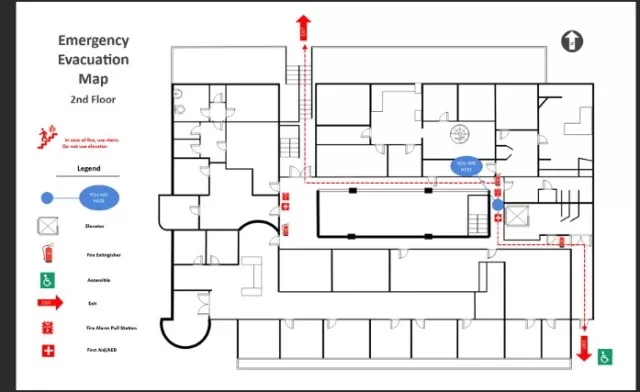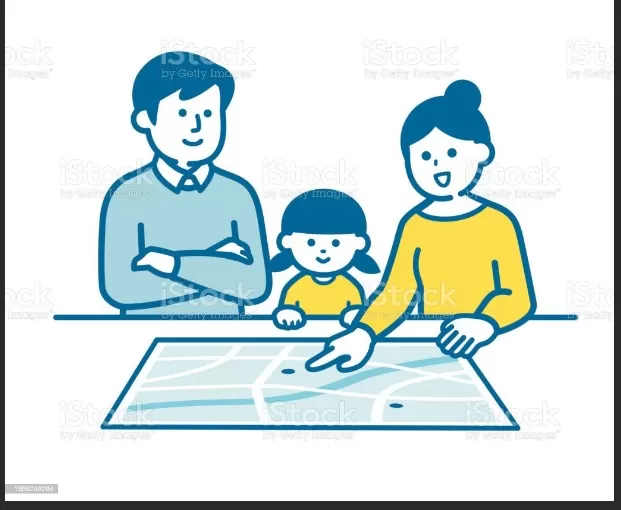Importance of a Household Evacuation Plan. Protecting your family during emergencies and unexpected situations requires a well-thought-out family evacuation plan.
By developing and practicing this plan, you can ensure that everyone knows what to do and where to go when faced with potential hazards.Remember, being prepared can make a critical difference during emergencies. A well-prepared family evacuation plan ensures that your loved ones can respond calmly and efficiently when faced with unforeseen challenges, safeguarding their safety and well-being.
Be Prepared, Stay Calm: Safeguarding Your Family in Emergencies

Emergencies strike unexpectedly, leaving behind a trail of devastation.
Surprisingly, a vast majority of people remain unprepared to tackle extreme situations should they arise. Alarming statistics from the Federal Emergency Management Agency (FEMA) reveal that an overwhelming 80 percent of Americans reside in counties that have experienced weather-related disasters since 2007.
Despite these shocking numbers, nearly 60 percent of American adults have not taken the time to practice emergency protocols for scenarios like tropical storms, brush fires, or other calamities. Additionally, a mere 39 percent have crafted a comprehensive evacuation plan.
In light of this, the importance of being prepared and having a well-thought-out household evacuation plan cannot be stressed enough.
Being knowledgeable about how to respond swiftly and efficiently during any emergency can mean the difference between life and death for you and your loved ones. A solid evacuation plan will not only ensure your safe exit from the immediate danger but also help in coping with the aftermath, facilitating a quicker recovery and getting you back on your feet as soon as possible.
Remember, preparation is the key to weathering the storm—both figuratively and literally.
By staying calm and being proactive in devising an evacuation strategy, you can ensure the safety and well-being of your family in the face of adversity. So, don’t panic, but instead, take the necessary steps to protect yourself and your loved ones from the uncertainties that emergencies bring.
Creating a Comprehensive Emergency Evacuation Plan: Understanding the Need for Evacuation
A well-structured evacuation plan plays a crucial role in safeguarding the lives and well-being of your household during emergencies.
The first and most vital step in this process is to hold a house meeting, bringing all family members together to discuss the potential dangers and the grave consequences of not evacuating in time. Ensuring that everyone comprehends the importance of the plan will foster a sense of responsibility and cooperation among all members.
The next important task is to identify the specific disaster risks that your area may face.
While it’s impossible to predict every potential threat, gaining knowledge about the most common hazards can significantly enhance preparedness. Researching data using smart devices and various weather apps will allow you to stay informed about your region’s vulnerability to events such as hurricanes, tornadoes, seasonal flooding, and other potential disasters.
In addition to natural calamities, it’s essential to be aware of other community-related hazards like major fires, power outages, or chemical spills.
Leveraging technology to set up alerts for such incidents will keep you informed about the situation in real-time, allowing you to make informed decisions during critical moments.
By proactively understanding the need for evacuation and staying informed about the risks and potential disasters in your area, your household will be better equipped to face emergencies with confidence.
Remember, knowledge is the first line of defense, and being well-prepared can make all the difference when seconds count in the face of adversity. So, invest the time and effort now to develop an effective evacuation plan, ensuring the safety and security of your loved ones during challenging times.
Enhancing Evacuation Safety: Establishing a Chain of Command and Communication Protocol

In times of emergency, a well-structured plan can make all the difference in ensuring everyone’s safety during evacuation.
One crucial aspect to address in advance is establishing a clear chain of command, especially when small children are involved. Designating a responsible individual to take charge and defining the flow of communication will prevent chaos and confusion, allowing for a smoother evacuation process.
To facilitate effective communication, create a comprehensive contact information list that includes extended family members, neighbors, and other important individuals or offices.
Ensure that essential contacts, such as medical facilities, doctors, schools, and service providers, are also included. Distribute this contact list among all family members and store it in everyone’s phone for easy access.
Additionally, keeping a printed copy in your evacuation kit ensures you have a backup in case of technology failures.
For families with younger children, it is vital to take extra precautions.
Teach your children to memorize your phone number, address, and full name. This information will serve as a lifeline for them if they ever get separated from you during an evacuation.
With this basic knowledge, authorities can better assist in reuniting your family during the aftermath of the emergency.
By proactively establishing a chain of command, fostering clear lines of communication, and preparing your family with necessary information, you significantly improve everyone’s chances of a safe and organized evacuation.
Remember, being prepared is not just about having supplies and equipment; it also involves having a well-thought-out plan and ensuring that every family member is aware of their roles and responsibilities in the event of an emergency.
Directing Priorities: Simplifying Your Evacuation Plan and Including Pets
When crafting an evacuation plan, the primary focus should be on ensuring the safe and swift evacuation of all family members.
The key to a successful plan lies in its simplicity, as complexity may lead to confusion during high-stress situations. Here are some essential steps to set the right direction and priorities for your evacuation plan:.
Establish Clear Meeting Places: Designate two disaster meeting places—one close to your home, such as a neighbor’s house, for immediate emergencies like residential fires, and another outside your neighborhood, such as a nearby park or coffee shop.
This way, if a family member is away from home when disaster strikes, they will know where to find you once they receive information about the evacuation. Make sure that all family members are familiar with the phone number and address of these locations.
Account for Pets: Pets are important members of the family, and including them in the evacuation plan is crucial.
Assign a specific family member the responsibility of handling the pets during an evacuation. This person should be tasked with leashing them or placing them in carriers for safe transport.
Be aware that many hotels and shelters only accept service animals, so it’s essential to gather information about pet-friendly accommodations and animal shelters along your evacuation routes.
By simplifying your evacuation plan and setting clear priorities, you can minimize the potential for confusion and ensure that everyone knows what to do and where to go in case of an emergency.
Remember, the safety and well-being of all family members, including pets, should be at the forefront of your planning efforts. With a well-prepared and straightforward plan, you can face emergencies with greater confidence and resilience.
.
Promoting Unity and Preparedness: The Importance of Evacuation Checklists

In times of crisis, having everyone on the same page can make all the difference in ensuring a safe and organized evacuation.
To achieve this, each family member should be assigned specific emergency responsibilities. By having well-defined roles, panic can be minimized, and the evacuation process can be executed more efficiently.
One effective approach is to create an evacuation checklist that outlines each individual’s tasks. Here are some essential items that should be included in the checklist:.
Emergency Kit or Go-Bag Assignee: Designate a family member responsible for retrieving the emergency kit or go-bag, which should be pre-packed with essential supplies.
This kit should be easily accessible and contain items such as non-perishable food, water, first aid supplies, flashlights, batteries, and important documents.
Children and Pet Coordinator: Another family member should take charge of ensuring that younger children and pets are prepared for evacuation.
This includes helping children memorize important information like phone numbers, addresses, and contact details and ensuring that pets are leashed or safely placed in carriers.
Communication Coordinator: Assign someone the role of keeping everyone informed and updated throughout the evacuation process.
This person can be in charge of relaying vital information, contacting emergency services, and keeping track of other family members’ whereabouts.
Transportation Planner: Depending on the situation, it might be necessary to designate someone responsible for arranging transportation, whether it’s coordinating the use of family vehicles or making arrangements for public transportation.
Meeting Place Organizer: Choose a family member to ensure that everyone is aware of the designated meeting places both within the neighborhood and outside, as established in the evacuation plan.
Document Keeper: Entrust a family member with the responsibility of safeguarding important documents, such as identification papers, insurance documents, and medical records, during the evacuation.
Utilities Shutdown: Assign someone the task of shutting down utilities (gas, electricity, etc.) before leaving the home to minimize potential hazards.
Having an evacuation checklist with specific assignments will help everyone understand their roles and responsibilities clearly.
This coordination will foster a sense of unity and preparedness, ensuring a more streamlined and efficient evacuation process during emergencies. Practice the evacuation plan regularly with all family members to reinforce their understanding and readiness.
Remember, preparedness is the key to safety and protection in uncertain times.
*The information is for reference only.